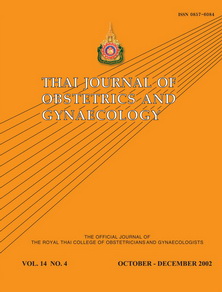Discordant Twins in King Chulalongkorn Memorial Hospital: 6 Years Review of Incidence and Outcomes
Main Article Content
Abstract
Objective To evaluate incidence and outcome of discordant twins in King Chulalongkorn Memorial Hospital, and assess the relationship between pregnancy outcomes and twin intrapair birth weight differences.
Methods Five hundred and nineteen twin gestations over 20 weeks of gestation during six
year period ending in December 2000 were retrospectively analyzed. Incidence and outcome
of discordant twins were assessed based on birth weight difference more than 20 %. All twin
pairs were stratified subsequently into five categories according to the percent difference of
infant birth weight. The relationship between different categories and the subsequent
pregnancy outcome were assessed. Statistical analysis was done using the Mantel-Haenzel c2
test.
Result Among 519 twin pairs, thirteen patients were identified to have single fetal demise
and two patients were documented to have dead fetuses of both twin pairs. Incidence of
discordant twins was 19.6% and greater birth weight difference was significantly associated
with cesarean section rate (p =0.03). Neonatal mortality, neonatal intensive care admission,
and low APGAR score were all associated with higher birth weight difference. (p < 0.001).
Conclusion Incidence of discordant twins based on the birth weight difference more than 20
percent in King Chulalongkorn Memorial Hospital was 19.6%, which corresponds to other
studies. In our study, we found that trend of poor neonatal outcomes related to high intrapair
birth weight differences.
Article Details

This work is licensed under a Creative Commons Attribution-NonCommercial-NoDerivatives 4.0 International License.
References
Erkkola R, Ala-Mello S, Piiro O, Kero P, Sillanpaa M.
Growth discordancy in twin pregnancies: a risk factor
not detected by measurements of biparietal diameter.
Obstet Gynecol 1985; 66: 203-6.
Blickstein I, Lancet M. The growth discordant twin. Obstet
Gynecol Surv 1988;43: 509-15.
Eberle AM, Levesque D, Vintzielos AM, Egan JFZ,
Tsapanos V, Salafia CM. Placental pathology in
discordant twins. Am J Obstet Gynecol 1993; 169: 1-5.
Blickstien I, Shoham-Schwartz Z, Lancet M, Borenstein
R. Characterization of the growth-discordant twin. Obstet
Gynecol 1987; 70: 11-5.
Rodis JF, Vintzielos AM, Campbell WA, Nochimson BJ.
Intrauterine fetal growth in discordant twin gestation. J
Ultrasound Med 1990;9: 443-8.
American College of Obstetricians and Gynecologists:
Preterm labor. Technical Bulletin No. 206, June 1995.
O’Brien WF, Knuppel RA, Scarbo JC, Rattan PK. Birth
weight in twins: an analysis of discordancy and growth
retardation. Obstet Gynecol 1986;67:483-6.
Sibai BM, Hauth J, Caristis S, Lindheimer MD,
MacPherson C ,Klebanoff M, et al. The National
Institute of Child Health and Human Development
Network of Maternal- Fetal Medicine Units:
Hypertensive disorders in twin versus singleton
gestations. Am J Obstet Gynecol 2000;182:938-43.
Lisa M.H, Donald D.M, Kenneth J.L. Outcome of twin
pregnancies according to intrapair birth weight
differences. Obstet Gynecol 1999;94:1006-10.
Sekiya S, Hafez ESE. Physiomorphology of twin
tranfusion syndrome. Obstet Gynecol 1977;50:288-92.
Robertson EG, Neer KJ. Placental injection studies in
twin gestation; Am J Obstet Gynecol 1983;147:170-5.
Leveno KJ, Santos-Ramos R, Duenhoester JN,Reisch
J, Whalley PJ. Sonar cephalometer after 28 weeks
gestation. Am J Obstet Gynecol 1980;138:615-9.
Papile LA, Burstein J, Burstein R, Koffler H. Incidence
and evolution of subependymal and intraventricular
hemorrhage: A study of infants with birthweights less than
gm. J Pedriatr 1978; 92:529-34.
Yalcin HR, Zorlu CG, Lembet A, Ozden S, Gokmen O.
The significance of birthweight difference in discordant
twins: A level to standardize? Acta Obstet Gynecol Scand
;77:28-31.

